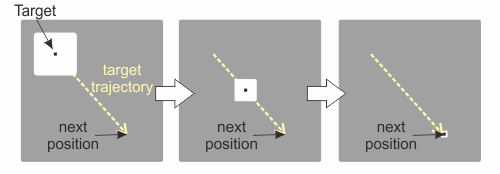Sample 04: Dynamic calibration target¶
What does this sample do?¶
This is an example of updateCalibrationTargetStimulusCallBack().
This method allows us to modify the calibration target frame by frame during calibration process.
This sample performs only calibration. Initialization processes is the same as those in Sample 01: Controlling SimpleGazeTracker from GazeParser.TrackingTools. The calibration target is presented on the center of the screen at the beginning of calibration. As shown in Figure 1, the target is a small black square surrounded by a large write square. When space key is pressed, the target starts moving to a new position. The surrounding white square becomes smaller as the target approaches to the new position.

Figure 1¶
Codes (PsychoPy)¶
Following codes replaces calibration target. The parameter of setCalibrationTargetStimulus() must be a stimulus object or a list of stimulus objects.
Here 'stimulus object' indicates that objects that can be renderd to the window by draw() method.
If a list of stimulus object is provided, they are drawn from the top of the list.
In this case, a white (fillColor=(1,1,1)) rectangle is drawn first. Then, a black rectangle (fillColor=(-1,-1,-1)) is drawn on the white rectangle.
calstim = [psychopy.visual.Rect(win,width=3,height=3,units='pix',lineColor=(1,1,1),fillColor=(1,1,1)),
psychopy.visual.Rect(win,width=2,height=2,units='pix',lineColor=(-1,-1,-1),fillColor=(-1,-1,-1))]
tracker.setCalibrationTargetStimulus(calstim)
Following codes update the size of calibration target frame by frame.
This is a callback' function, which is automatically called by GazeParser.TrackingTools.BaseController.doCalibraion' and :func:`GazeParser.TrackingTools.BaseController.doValidation() during calibration and validation.
def callback(self, t, index, targetPos, currentPos):
if index==0:
return
else:
if t<1.0:
self.caltarget[0].setSize(((10-9*t)*3,(10-9*t)*3))
else:
self.caltarget[0].setSize((3,3))
type(tracker).updateCalibrationTargetStimulusCallBack = callback
This callback function receives four parameters shown in Table 1.
In this sample, the size of the calibration target is changed from 30 to 3 depending on the value of t.
self.caltarget holds stimulus object(s) registered by setCalibrationTargetStimulus().
If setCalibrationTargetStimulus() is not used, self.caltarget holds a psychopy.visual.Rect object as default.
Parameter |
Description |
|---|---|
t |
time spent for current target position. The unit is seconds. The range of t is 0.0<=t<2.0. When 0.0<=t<1.0, the calibration target is moving to the current position. When 1.0<=t<2.0, the calibration target stays on the current position. Calibration data is sampled when 1.4<t<1.8. |
index |
This value represents the order of current target position. This value is 0 before calibration is initiated by space key press. If the target is moving to or stays on 5th position, this value is 5. |
targetPosition |
A tuple of two values. The target is moving to or stays on the position indicated by this parameter. |
currentPosition |
A tuple of two values that represents current calibration target position. This parameter is equal to targetPosition when 1.0<=t<2.0. |
注釈
The range of t can be customized in version 0.6.0 by using following parameters.
See Sample 05: Custmizing calibration target motion, Configure GazeParser, setCalTargetMotionParams() and setCalSampleAcquisitionParams() for detail.
If you have to access the entire list of calibration target positions, you can refer following data attributes of GazeParser.TrackingTools.BaseController().
Attributes |
Description |
|---|---|
self.caltarget |
This attribute holds stimulus object(s) for drawing calibration target.
This attribute is set by |
self.calTargetPos |
This attribute holds a list of calibration target positions.
This attribute is set by |
self.valTargetPos |
This attribute holds a list of validation target positions.
This list is internally generated from self.calTaretPos everytime
|
self.indexList |
This attlibute holds the order in which calibration target visits positions listed in self.calTargetPos or self.valTargetPos. That is, if the target is staying on the 5th position in self.caliTargetPos, self.calTargetPos[self.indexlist[5]] is the position of the target. |
Codes (VisionEgg)¶
注釈
VisionEgg backend is no longer supported by 0.11.0 or later.
Please read comments on the codes for PsychoPy.
The main difference is that setCalibrationTargetStimulus() must be an object or a list of objects of VisionEgg stimlus.
calstim = [VisionEgg.MoreStimuli.Target2D(size=(5,5),color=(1,1,1)),
VisionEgg.MoreStimuli.Target2D(size=(2,2),color=(0,0,0))]
tracker.setCalibrationTargetStimulus(calstim)
def callback(self, t, index, targetPos, currentPos):
if index==0:
return
else:
if t<1.0:
self.caltarget[0].parameters.size = ((20.0-19.0*t)*5,(20.0-19.0*t)*5)
else:
self.caltarget[0].parameters.size = (5,5)
type(tracker).updateCalibrationTargetStimulusCallBack = callback
